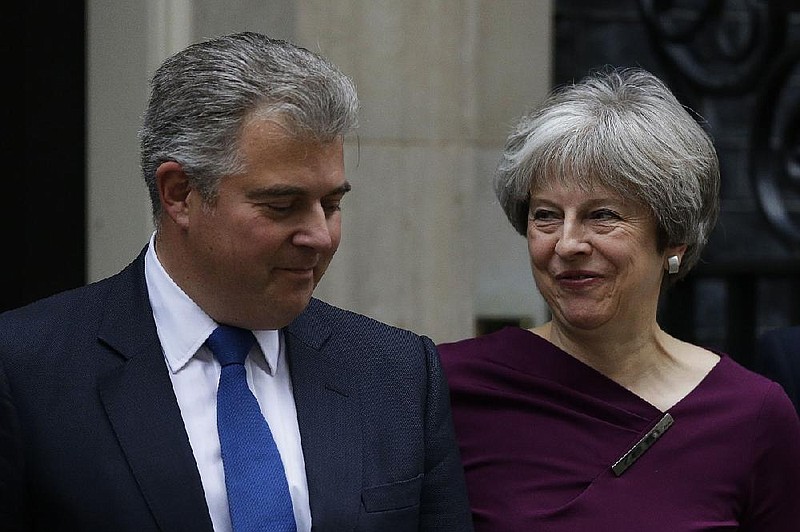LONDON -- Prime Minister Theresa May of Britain began reshuffling her Cabinet on Monday, seeking to exert her authority over a government that has often struggled to control events as it negotiates the country's exit from the European Union.
The most senior figures in May's Cabinet, including the foreign secretary, Boris Johnson, and the chancellor of the Exchequer, Philip Hammond, kept their jobs in the shake-up, despite calls for them to be moved or dismissed.
That underscored May's lack of room for maneuvering, seven months after a general election in which she lost her parliamentary majority, damaging her authority, and as difficult negotiations loom over Britain's withdrawal from the European Union.
May's reshuffle got off to a rough start when her Conservative Party's Twitter account announced the appointment of Chris Grayling as party chairman. The post, which proved inaccurate, was deleted, but not before it had been spotted by political reporters.
A later announcement of Brandon Lewis' appointment as the new Conservative Party chairman, replacing Patrick McLoughlin, was not problem-free, either. The original post on Twitter misspelled his new title, minister without portfolio, leaving out the "t" in "portfolio."
The Cabinet changes -- at least two secretaries out and seven officials promoted -- are May's first major effort to refashion her top team, after months of speculation about her future. Those questions only increased after May's performance at the Conservative Party's annual conference in October and the subsequent resignation of three Cabinet ministers.
Even though May's de facto deputy, Damian Green, stepped down last month after he was found to have misled the public about pornography found on his work computer, she appeared to be in a stronger position than at any time since the general election in June.
The prime minister reached an agreement with EU leaders in December to proceed with talks on trade relations after Britain leaves, a process that is scheduled to take effect in March 2019. The accord was achieved without reawakening acute tensions in the Conservative Party over the extent of the post-exit ties between Britain and the bloc.
May's Cabinet has been carefully constructed to balance those like Hammond who want to keep a close economic relationship with the European Union, and those like Johnson who argue for a cleaner break.
A desire to maintain that equilibrium partly explains why the two men remained in their posts, despite criticism of Johnson's performance as foreign secretary and calls from hard-line exit supporters for Hammond to be fired.
May's reluctance to risk moving any senior colleagues, and the botched announcement of the new Conservative Party chairman, were described by some commentators in the British news media as the "day of the blunt knives."
The headline on the website of the right-leaning Daily Telegraph described the reshuffle as "chaotic." The BBC's political editor, Laura Kuenssberg, noted the slow pace of announcements and made an ironic reference to May's widely mocked statement, made after modifying plans for social care during last year's election campaign, that "nothing has changed."
"You might almost say, almost 'nothing has changed' [so far]," Kuenssberg wrote on Twitter about the reshuffle.
One minister who did leave the Cabinet was James Brokenshire, who resigned as secretary of state for Northern Ireland for medical reasons, telling May in a letter that he needed surgery to remove a small lesion in his right lung.
Meanwhile, Green's position at the Cabinet Office was filled by David Lidington, who moved from his job as justice secretary.
May wanted to try to use the reshuffle to try to freshen the government's approach to domestic issues, after nearly year of obsessive focus on Britain's EU exit.
But most analysts believe that she is likely to be stymied in that objective. Lacking a parliamentary majority, May must often rely on 10 lawmakers from the ultraconservative Democratic Unionist Party of Northern Ireland to push legislation through. That weakness was implicitly acknowledged Sunday, when May said that she had abandoned plans for a vote on whether to reverse a ban on the divisive issue of fox hunting.
And, despite her intention to focus more on domestic matters, the next 12 months are likely to be dominated by negotiations with the EU, leaving ministers with little time or energy to tackle issues like health, transportation and housing.
A Section on 01/09/2018
